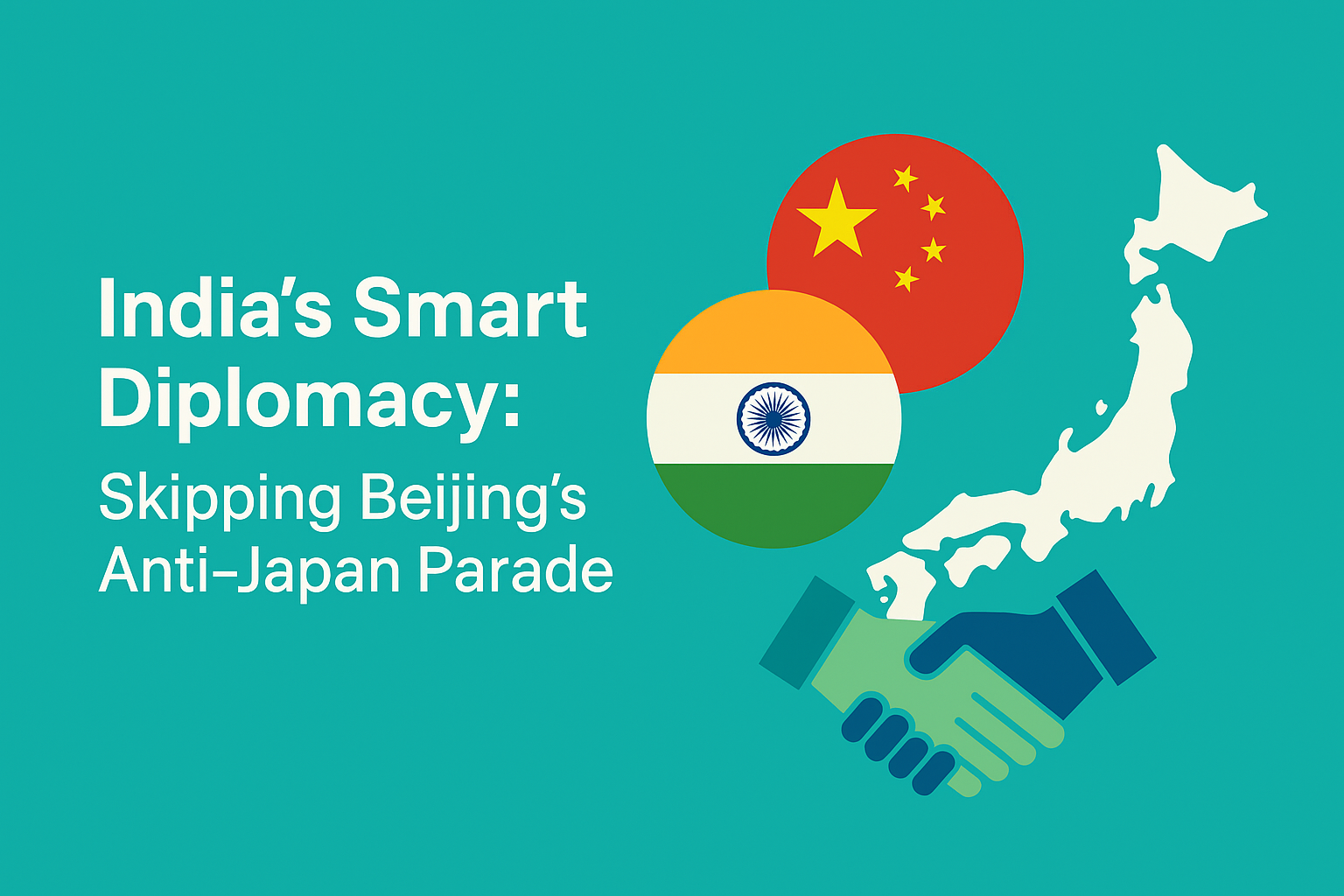- Introduction: A Test of Diplomatic Wisdom
- Protecting Ties with Japan: A Calculated Absence
- Preserving Flexibility with China: Absence Without Confrontation
- Balancing the Global South and the West
- Risk Management Through Strategic Ambiguity
- Domestic and International Messaging
- Lessons for International Society
- Conclusion: The Smart Power of Strategic Autonomy
Introduction: A Test of Diplomatic Wisdom
In a world increasingly defined by polarization and great-power rivalry, nations are often pushed to take sides. The United States and its allies on one hand, and China and Russia on the other, both compete for influence across Asia and beyond. Against this backdrop, India has once again demonstrated the art of strategic autonomy. By choosing not to participate in China’s September 3 “Victory Over Japan” parade, New Delhi signaled restraint and clarity in equal measure. It was not an act of hostility toward Beijing, nor a sign of subservience to Tokyo or Washington. Instead, it reflected a mature, calculated diplomacy that seeks to preserve space for India’s own global ambitions.
Protecting Ties with Japan: A Calculated Absence
The Beijing parade, officially commemorating the 80th anniversary of World War II’s end, carries a strong anti-Japan undertone. For Tokyo, such symbolism is unwelcome, even provocative. India, which shares with Japan a “Special Strategic and Global Partnership,” understood the stakes.
By abstaining, New Delhi reassured Tokyo that their partnership is not subject to sudden swings or opportunistic moves. This was critical because Japan remains a central pillar in India’s Indo-Pacific strategy, from defense cooperation to infrastructure finance. Participation in an event framed as “anti-Japan” could have cast doubt on India’s reliability as a partner.
Preserving Flexibility with China: Absence Without Confrontation
Yet, India did not turn its back on Beijing. Prime Minister Narendra Modi traveled to China only days earlier to attend the Shanghai Cooperation Organisation (SCO) summit in Tianjin, where he engaged in direct talks with President Xi Jinping. While border disputes and trade imbalances remain unresolved, the very act of dialogue underscored India’s willingness to compartmentalize differences and seek pragmatic cooperation.
By skipping the parade but attending the summit, India effectively told China: “We will work with you where interests align, but we will not be drawn into symbolic gestures that compromise our other relationships.” This nuanced signaling helps India avoid being painted as anti-China while maintaining strategic room to maneuver.
Balancing the Global South and the West
India’s refusal to attend the parade also resonates with its broader role as a leader of the Global South. Many emerging nations look to New Delhi not as a proxy of Washington or Beijing, but as a sovereign voice advocating fairness in global governance. By avoiding a historical-memory event that divides Asia, India demonstrated that it seeks to focus on future-oriented cooperation—in trade, connectivity, and technology—rather than on divisive wartime narratives.
At the same time, India’s absence reassured Western partners. The United States, Japan, and Europe, all of whom view China’s historical commemorations with suspicion, could read this as India’s subtle alignment with their sensitivities—without India ever making a formal declaration of allegiance.
Risk Management Through Strategic Ambiguity
Diplomacy is often the art of minimizing risks while maximizing options. Participation in the parade could have harmed ties with Japan and raised eyebrows in Washington. A total boycott of Chinese engagements, on the other hand, would have undermined India’s position in the SCO and strained economic exchanges with Beijing.
Instead, India chose the middle path: engagement without endorsement. This is classic strategic ambiguity—a way to extract value from all sides without committing prematurely. Such risk-averse positioning is not weakness; it is prudence. It ensures that India does not mortgage its future to one camp or another, keeping doors open for multilateral cooperation.
Domestic and International Messaging
Domestically, Modi’s decision projects independence. By neither succumbing to Western pressure nor falling into Beijing’s embrace, the government reassures the Indian public that foreign policy remains firmly sovereign. Internationally, the message is equally clear: India is not a pawn in someone else’s game but a player capable of setting its own agenda.
This balancing act resonates well with India’s narrative of being the “Voice of the Global South.” It underscores that New Delhi is not merely reacting to global shifts but actively shaping them.
Lessons for International Society
From a broader perspective, India’s decision offers lessons for other middle powers:
- Avoid symbolic traps. Historical commemorations can be politically charged; wise states avoid entanglement unless national interests demand it.
- Balance through presence and absence. Attending the SCO summit but skipping the parade shows how selective engagement preserves flexibility.
- Preserve credibility with key partners. India’s sensitivity to Japan’s concerns strengthens its reputation as a trustworthy ally.
- Leverage ambiguity. By staying non-committal in symbolic disputes, India maximizes its strategic options in both East and West.
Conclusion: The Smart Power of Strategic Autonomy
India’s decision to skip Beijing’s anti-Japan parade was not an act of passivity—it was a deliberate demonstration of diplomatic intelligence. By shielding relations with Japan, keeping channels open with China, and projecting independence to the wider world, New Delhi once again showcased why strategic autonomy is its greatest foreign policy asset.
In an era where many nations are cornered into binary choices, India stands out as a country capable of walking a middle path. This risk-averse yet forward-looking posture strengthens India’s role as a mediator, a balancer, and a global leader.
For the international community, India’s example is a reminder that sometimes, the wisest move is not to march in another’s parade—but to chart one’s own path.


